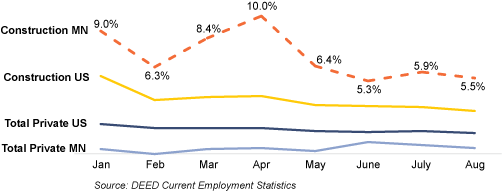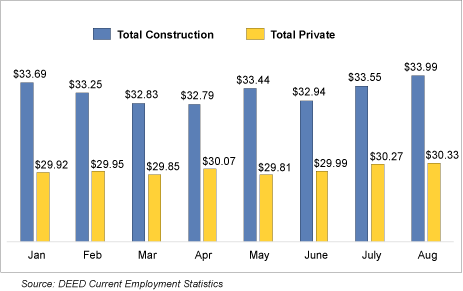
by Sanjukta Chaudhuri
September 2019
Diverse workers will be critical to the industry’s survival and growth.
Construction has been an engine of job growth in Minnesota since 2011. The level of construction activity is an important indicator of economic conditions, with more construction and building permits indicative of a strong economy. Falling construction activity is usually deemed an early indicator of an economic downturn. Residential building permits is one indicator used in DEED’s Economic Index. This snapshot looks at how Construction has fared in Minnesota this year.
Construction is projected to grow 8.9 percent by 2026, according to DEED’s Employment Outlook data tool. The Construction workforce tends to be younger and male-dominated (87.6 percent male). In 2018, over 63 percent of Construction employees were age 19-44 years, compared to 59 percent for the private sector. Construction jobs generally require a high school diploma or post-secondary certificate for entry. As a result, educational attainment of construction employees is lower than across the private sector. Fifty-five percent of Minnesota’s Construction workforce has some college or more compared to 64 percent across the total workforce.
In August, 144,575 workers were employed in the Construction sector, or slightly under 5 percent of total non-farm employment. Over the year, Construction has grown faster than any other sector in Minnesota, up 5.5 percent in August. Construction in Minnesota has also outpaced the U.S. in over-the-year growth throughout 2019 (Figure 1).

Wages in Construction were far above average at $33.99 compared to $30.33 across all private sector jobs in August (Figure 2). Construction employees worked an average of 41.1 hours per week in August, in contrast to 34.1 hours across the private sector.

Looking at constituent industries, Residential Construction grew in all months of 2019, and most recently grew by 2.3 percent over-the-year in August. Heavy and Civil Engineering, which has had a mixed year so far, declined by 5.4 percent over-the-year in August. Specialty Trade Contractors has had unadjusted growth in jobs every month so far in 2019, with over-the-year growth of 9.4 percent in August.
While the outlook for Construction is positive, the sector is highly sensitive to business cycles. A recession would likely negatively affect Construction. Construction needs to diversify its workforce by recruiting more women and minorities to fill open positions during the tight labor market that Minnesota is experiencing. Diversifying the workforce will most certainly turn out to be a critical survival and growth strategy for Construction.